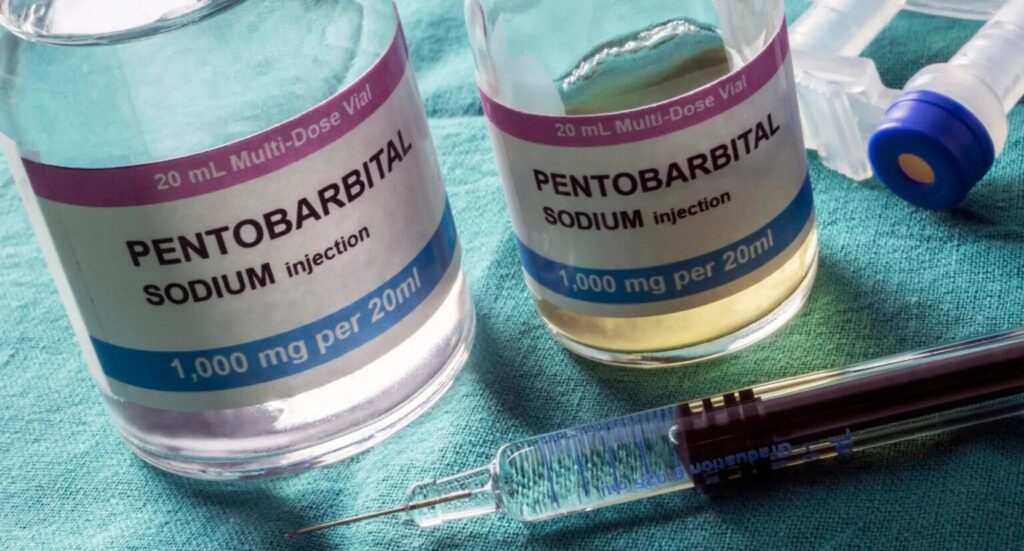
Sodium pentobarbitone is the sodium salt form of pentobarbital, a short-acting barbiturate that has played an important role in both human and veterinary medicine. Historically, it was used as a sedative, hypnotic, and anesthetic agent due to its ability to depress the central nervous system. Its fast onset of action made it useful in surgeries or emergency situations where rapid sedation was necessary. However, because of safety concerns such as overdose potential and dependency, the use of sodium pentobarbitone in human medicine has been greatly reduced. In veterinary medicine, it continues to have a role, especially in providing anesthesia for procedures and in humane euthanasia, where its rapid effectiveness is highly valued by professionals.
Sodium Pentobarbital Drug Class Explained
To understand its function, it is essential to know the sodium pentobarbital drug class. Sodium pentobarbital belongs to the class of barbiturates, which are central nervous system depressants. Drugs in this class enhance the activity of gamma-aminobutyric acid (GABA), an inhibitory neurotransmitter in the brain. This action reduces neuronal excitability, leading to sedation, hypnosis, and anesthesia. The sodium pentobarbital drug class is known for its potency, but also for its high risk of overdose and dependency, which is why barbiturates as a whole have been replaced in most medical practices by safer alternatives such as benzodiazepines. Despite these limitations, understanding its classification highlights why sodium pentobarbital is still carefully utilized in specific, controlled medical and veterinary contexts.
Clinical Applications of Sodium Pentobarbitone
In professional healthcare and veterinary environments, sodium pentobarbitone has clear clinical applications. In the past, it was used in human medicine to manage severe insomnia, seizures, and for preoperative sedation. Today, however, its most prominent application is within veterinary medicine. It is administered intravenously for animal anesthesia during surgery or as a euthanasia agent when a painless and quick passing is required. Because of its powerful effects, its administration requires precise dosing and monitoring. The fact that sodium pentobarbitone remains in use for these critical roles underscores the enduring value of barbiturates in very specific situations, despite their decline in broader medical practice.
Risks and Limitations of Sodium Pentobarbital Drug Class
Although the sodium pentobarbital drug class provides effective sedation and anesthesia, the risks associated with barbiturates cannot be ignored. Side effects may include dizziness, impaired coordination, confusion, and respiratory depression. At higher doses, sodium pentobarbital can suppress breathing and heart function, leading to coma or death. Another limitation is the risk of dependency, as repeated use can cause the body to build tolerance, requiring larger doses for the same effect. Withdrawal symptoms can also be severe, including anxiety, tremors, and seizures. These risks explain why sodium pentobarbital and other barbiturates are now tightly controlled substances, prescribed or administered only when no safer alternatives are available.
Balancing Utility and Safety in Modern Medicine
The discussion of sodium pentobarbitone and the sodium pentobarbital drug class demonstrates the balance between therapeutic utility and patient safety. While these compounds once had a broader role in human healthcare, their risks have led to stricter regulations and a focus on safer substitutes. In veterinary practice, however, they remain valuable tools for anesthesia and euthanasia, highlighting their continuing relevance. The modern approach emphasizes regulation, awareness, and professional oversight to ensure their benefits are realized without exposing patients or animals to unnecessary harm. By understanding their drug class, medical history, and risks, we can appreciate the cautious yet essential role sodium pentobarbital still plays in specialized care today.
Leave a Reply